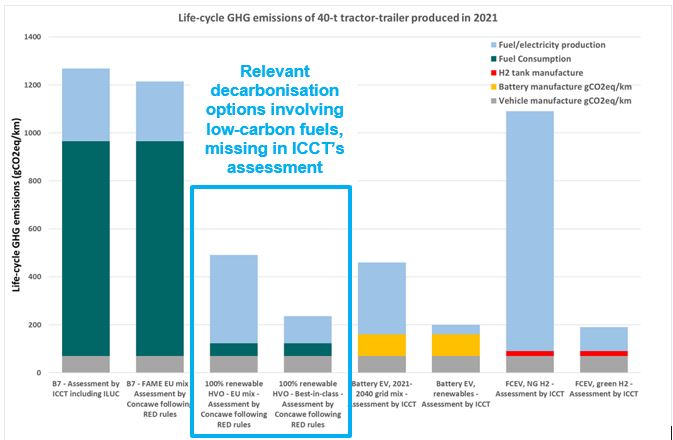ICCT HDV CO2 report fails on the most important questions
The ICCT work sets out to inform policy decisions with science, a worthy objective. Of course, this immediately clarifies that there is no such thing as a zero-emission vehicle, even those without a tailpipe. This is welcome honesty. Regrettably, this report from the ICCT ignores that renewable fuels in Internal Combustion Engine (ICE) vehicles can be just as good as electric trucks on GHG emissions, with an unexplained, highly selective scientific study.
John Cooper, Director General FuelsEurope, stated “There were some very strange decisions to include, and exclude things in this work that have hugely influenced the conclusions. Thankfully complementary work by Concawe can fill the gaps and give a more complete scientific picture.”
Trucks operating on 100% biofuels are missing from the study
First and foremost, the option to operate a truck on 100% renewable biofuels is simply missing, whereas the options to operate on 100% renewable electricity or 100% green H2 are shown. Although another renewable fuel is considered, it is only about Power-to-Liquid (PtL also known as e-fuels), only after 2030, and only with a content limited to 2.6 - 5.7% up to 2049, which is obviously inconsistent with the decarbonisation targets in this time horizon. Furthermore, the ICCT never compared in the same graph the benefits of PtL for decarbonisation of trucks to the benefits of electrification, this remains a sign of an unbalanced approach.
Without waiting the 2030 horizon and already available today, it is a matter of record that the GHG intensity of sustainable biofuels has decreased since the beginning of the RED in 2010. Taking average 2022 values for biodiesel in Germany, an 80% reduction vs fossil fuels, a truck operated exclusively on 100% renewable (non-fossil) fuel would have a GHG footprint equal to that of an electric truck.
Why would we want to exclude that option? Especially when 98% of today's trucks and all of the current fuels distribution and charging infrastructure is already in place and completely compatible with 100% renewable fuels.
John Cooper commented “therefore, we present the ICCT graph with adjustment to remove ILUC and to add in the option for 100% biofuels in 2021 in efficient ICE trucks. They can be as good as an EV.”

Not the correct unit to assess GHG emissions
Secondly, the ICCT report shows GHG emissions per mile, when per tonne-mile would be the correct unit. We know already that an electric truck is likely to have a lower payload because of high battery weight, and more time for recharging. This means it may take more than one truck to replace a truck running on (any type of) liquid fuel. This choice of units ignores these likely drawbacks of electric trucks and creates additional bias flattering the electric truck.
Biofuels indirect emissions should not be accounted for in the study
Thirdly, in ICCT’s report, the baseline for diesel & biofuels emissions are almost certainly exaggerated; Indirect emissions[1] are claimed for biofuels, thus significantly inflating the baseline emissions set out in this “test”. There are certainly indirect emissions for the transition to electric trucks (e.g. building the charging infrastructure) but these are ignored. This asymmetry gives a certain bias.
Science shows that ICE trucks with 100% renewable fuels are as effective in reducing GHG emissions
John Cooper underlined “Good science means including the full picture - not just the results one would like to show. Good policy decisions can only be made with good, complete science as a foundation.” The excellent GHG performance of ICE trucks with 100% renewable fuels is a critical opportunity to have additional, complementary technologies to increase the probability of reaching 2050 climate-neutrality targets.
We urge policymakers to recognise the importance of retaining renewable liquid fuels as part of the future of European Heavy Duty Vehicles (HDV) transport, ensuring transport companies can choose this technology for the long term to deliver both climate-neutral targets and goods to society.
[1] ILUC (Indirect Land Use Change) values cannot be measured, can only be estimated after certain choices of attribution have been made, and these depend hugely on many uncertain and unstable factors. For this reason they do not feature in the RED (Renewable Energy Directive) sustainability standard, and we would say they do not belong in this study.


